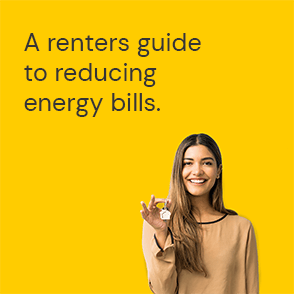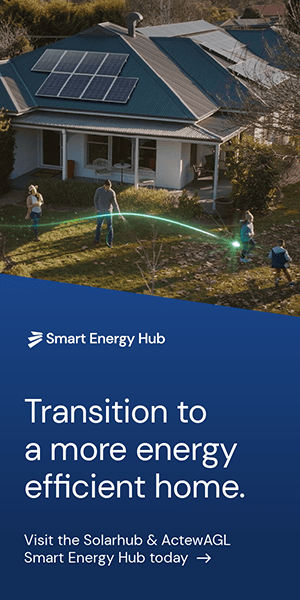ENERGY SAVINGS
A renters guide
to reducing
energy bills.
According to the Climate Council’s Smarter Energy Use report, renters spend a higher percentage of their income on energy bills than owner occupiers. If you’re one of the 25% of Canberrans renting, you may be curious how you can reduce your energy bill.
Although not owning the property may prevent you from making large scale energy-efficient upgrades, there are still a number of ways you can lower your bills as a tenant. From sealing draughty cracks to creating mindful energy consumption habits, these small yet effective tips can amount to significant savings on your monthly energy costs.
Seal draughty gaps and cracks
If your home has gaps or cracks around windows and doors, these will be leaking precious heated or cooled air. Heating and cooling accounts for 40% of Australian household energy use, and by taking care of draughty gaps and cracks, you can cut down your energy bills by up to 25% according to energy.gov.au.
Sealing gaps and cracks is a fairly straight-forward job you can carry out yourself without needing your landlord to step in. Inspect your home for gaps and cracks around windows, doors and holes in walls, floors and ceilings. Then, consider temporary versus more permanent solutions. If using a temporary solution that is easy to remove without damaging the property, you can usually go ahead with those adjustments. If you’re looking at more permanent options, speak to your landlord about your chosen method of repair. Vinyl, foam or rubber weather-stripping is great for sealing gaps around doors and windows, while caulking can be used to seal gaps between building components such as the window frame and the wall. A simple draught excluder placed on the floor alongside doors will prevent unwanted air escaping or entering, without overusing heating or cooling.
Swap traditional bulbs for LEDs
According to the ACT Government, about 4% of Canberran household energy use is taken up by lighting. By switching halogen light bulbs to LED lighting, you can expect to save on your electricity bills significantly.
What makes LEDs a cost-effective lighting solution? The Department of Climate Change, Energy, the Environment and Water has found that LEDs produce light up to 90% more efficiently than traditional incandescent light bulbs and use 75% less energy than halogen bulbs. What’s more, LEDs last between five to ten times longer so you can reduce your replacement costs and the number of light bulbs that end up in landfill.
You’ll find LED bulbs at local hardware stores, online retailers and many supermarkets. When shopping around, choose the right wattage for your home, consider the colour temperature too to create the desired atmosphere for the room.
Create mindful energy consumption habits
Whether you live alone or in a shared household with other tenants, collectively creating new habits of consuming energy sparingly will save you money. The Australian Government has found that leaving electronics on standby can contribute up to 10% of your electricity bill so switch off TVs, plugged in devices, speakers and computers fully at the end of the day. Remember; if it has a digital clock on, it’ll be still draining power! Even better you can use smart power boards to remotely turn off appliances or set a timer to switch on or off.
Always turn lights off when exiting a room and use appliances like washing machines and dishwashers on their shortest or most energy-efficient cycles. Avoid running smaller loads as it takes the same energy to run a full washing machine or dishwasher as it does a partially empty one.
When your large appliances are reaching their end of life, speak to your landlord to discuss getting energy-efficient replacements that will help save you and your landlord money long-term.
Summary
- Sealing draughty gaps and cracks with weather-stripping or caulking can cut down energy bills by up to 25%.
-
By switching halogen light bulbs to LED lighting, you can expect to save on your electricity bills significantly.
- Creating new mindful energy consumption habits like switching off electronics completely at night, turning off lights and running appliances on energy-efficient cycles will cut down energy costs.
ActewAGL's energy saving tips are designed to help you take control of your energy use, while reducing your bills and environmental impact. Save with great value energy plans backed by our sustainability promise, supported by 100% local, award-winning service - so you can LIVE A Good Life now and into the future.
For more information about how you can transition to an energy-efficient home visit the SolarHub & ActewAGL Smart Energy Hub today.
Sources
https://www.climatecouncil.org.au/wp-content/uploads/2023/04/CC_MVSA0353-CC-Report-Two-for-One-Home-Energy-Efficiency_V5.1-FA-Screen-Single.pdfhttps://profile.id.com.au/australia/tenure
https://www.energy.gov.au/sites/default/files/seniors_guide_to_energy_saving.pdfhttps://www.actsmart.act.gov.au/__data/assets/pdf_file/0012/697287/Actsmart-Household-Energy-Savings-Guide-June-2018-updates-FINAL.pdf
https://www.energy.gov.au/households/lighting
https://www.energy.gov.au/households/household-guides/5-ideas-saving-energy-and-money
https://www.actewagl.com.au/energy-savings/dishwasher
Disclaimer: These Energy Savings tips and articles are for information purposes only. Please ensure you are aware of any safety precautions before operating appliances or products.



